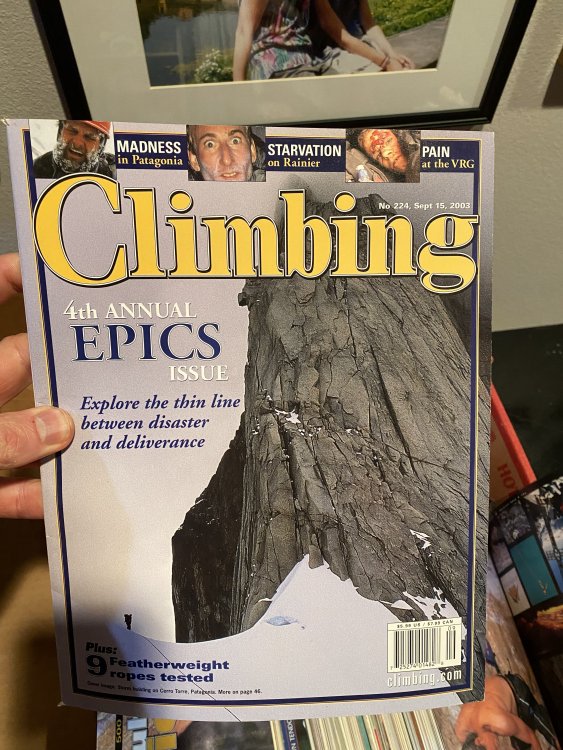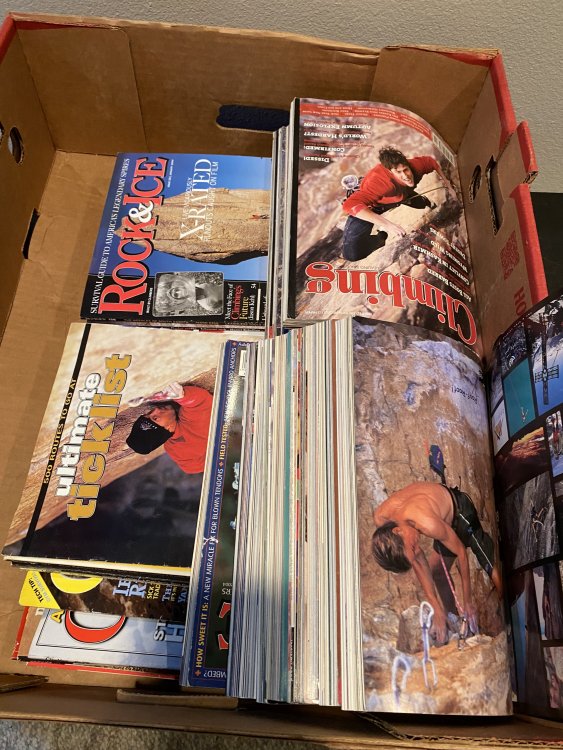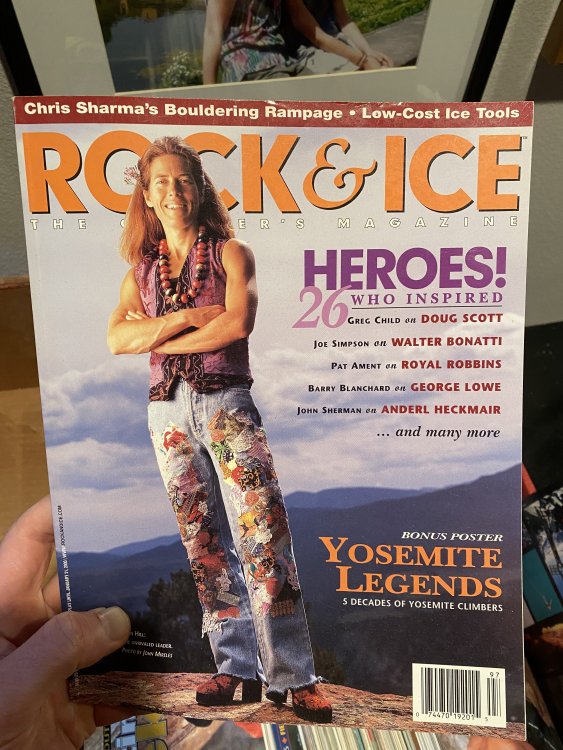
Peter McCorkell
Members-
Posts
17 -
Joined
-
Last visited
About Peter McCorkell
- Birthday 11/26/2017
Peter McCorkell's Achievements
Gumby (1/14)
0
Reputation
-
Free climbing magazines. Rock and Ice and Climbing all from the late 90s -early 2000s. All in very good condition. Pretty cool to look through. 2 decent sized boxes. Please take them all. You can text me. 619-six93- 0044 some pics aren’t uploading. Easier to look at them here. https://seattle.craigslist.org/see/spo/d/seattle-freeclimbing-magazines/7325060239.html
-
[TR] Mt. Triumph - North East Ridge 5.7 8/8/2012
Peter McCorkell replied to Eric T's topic in North Cascades
Yeah Whitney!! Nice! -
Wow, this looks awesome. Do you have a link to where you could buy this online? It didn't look like there are any purchase options on the USGS website...
-
John Muir's writings are excellent. The account of his 1875 epic on Mt. Shasta in which he spent the night rolling back and forth in the fumaroles is incredible: http://www.yosemite.ca.us/john_muir_writings/snow_storm_on_mount_shasta/ I believe it's also found in The Wild Muir, a collection of his short stories.
-
[TR] Mount Stuart - Complete North Ridge 7/26/2010
Peter McCorkell replied to Peter McCorkell's topic in Alpine Lakes
Thanks. We're not really sure. It probably would have been a nice idea to weigh them. A lot lighter than before that's for sure, and it was awesome. We did go straight up from the top of the second pitch. I think this is what Beckey recommends, and it was a nice pitch although, yes, I do remember having to down-climb. This would connect with where you would end up if you traversed off right. Which, I think, is what Nelson recommends (based on the little line on his topo). We were pretty happy with what we did, it was a cool, exposed pitch. There was a little snow at the top of the Cascadian Couloir. For the most part it was pretty easily avoided or not steep enough to cause problems. I'm sure it's much less now. Sent you a PM w/ a few more details. -
Trip: Mount Stuart - Complete North Ridge Date: 7/26/2010 Trip Report: Two weeks ago Benjamin G and I climbed the Complete North Ridge of Mount Stuart. We spent one night on the route, bivying below the Great Gendarme, and exited via the Cascadian Couloir. Our trip was preceded one attempt on the same route weeks earlier that ended with a retreat down the 4th class gully leading to the Notch at 8200ft. On that trip, we awoke late at the Colchuck Lake TH and didn’t start climbing until around 12:30pm. Struggling on the bottom pitches, we climbed slowly, bivying on a small, uneven ledge about a thousand feet below the Notch. We had planned to descend the Sherpa Glacier and were carrying boots, steel crampons, and axe. By the time we reached the Notch the next day, we realized our pace was not fast enough and decided to bail. One bonus of the trip (besides all the lessons learned) was seeing the largest herd of goats I’ve ever seen in the PNW: We returned to the route last week and, with both of our imminent departures for grad school on the east coast, decided to stack all the odds in our favor to complete the route. Leaving a car at the Lake Ingalls TH, we slept at the Colchuck Lake TH and readied our packs the night before. Ben had awake at 1am and we were on the trail by 2. The hike up to the climbers trail went a little too quickly and we started out on the bushwhack in the dark. After getting a bit turned around, we decided it’d be a good idea to wait until it was a little bit light out, and rested for about 45min until 4:45 and we could see a little better. We stayed on a path that was higher than the one described in the guidebooks (it never contacted the Mountaineers Creek) and followed cairns through solid talus for a ways until the path steepened to gain the upper valley. We reached the base of the climb and started climbing at 7:30, the same time that we had left the car on our previous trip! Approaching the base: Doing the hard pitches before really helped us climb them quickly this time. I took the first pitch, and instead of repeatedly looking at the crux move between placements of more gear to my ‘cam nest’, I was able to place the gear I needed and confidently move through. Ben had the next pitch, one that Blake Herrington has called the best and hardest pitch on the CNR. He also climbed it quickly and well, and I followed, liebacking probably more than I should have. (Sorry, no pics of this pitch). After another pitch or two, we began simulclimbing. We knew from our last trip that we’d have to pick up some speed on simuling and change our mindset to move quicker on the route. Last time we spent a little too much time looking around, trying to find ‘the right way.’ Avoiding steeper sections for shallower, dirtier ones, which added lots of time. A new attitude of ‘don’t make it too hard, don’t make it too easy’ was perfect for this lower section of the ridge and we reached the notch sometime around noon, helped by an impressive near 1000ft. simul lead by Ben. Pointing at something: There was plenty of snow at the Notch and hot temps made it possible to stuff some in a Platy and continue moving. Above the Notch things continued to go well, we pitched out a couple of pitches, including the 5.7, and another that was exposed and had lots of rope drag. Climibing Nelson’s ‘Slab with Crack” We reached the bivy a few pitches below the Great Gendarme around 3pm and were able to gather snow for water. I wouldn’t think that this snow field would be around for that much longer. The Great Gendarme in the alpenglow from the bivy We spent the next hour or two eating and melting snow and tried to cover up as best we could to avoid the horrendous mosquitoes. There were two bivy sites where we were, both looked like they would be quite comfortable for 1 person and uncomfortable but doable for 2. To shed weight, we chose to sleep in puffys, and not bring sleeping bags or for me, a sleeping pad. This really helped us climbing and, because it was a pretty warm week, wasn’t too bad on the upper ridge. Covering up from the ‘skeeters The next morning, we awoke with the light and headed out. I took the first pitch of the Gendarme, and Ben followed: I belayed for the next pitch from the uber-classic ledge: Looking up at the 2nd pitch of the Gendarme. Ben leading up the 2nd pitch: Both pitches of the Gendarme went well. The first pitch had some really nice stances in it, gear was easy, and the feet were pretty good for liebacking the upper part of it. The second pitch also nice. The outside of it definitely was wide, but at the back of the crack, where most of the hands were, was almost all fists or even big hands. Yes, the fixed #4 is still there. Fun, blocky climbing lead us to the summit. It’s always fun to see friends in the register. Hey Dave! There were lots of bivy spots at the summit and if we had known this might have considered continuing to the summit the previous day, but being fresh for the Gendarme was definitely a good thing. Descending the Cascadian Couloir in our tennis shoes went well and we started up the Ingalls Creek trail. I think it was only about 2pm at that time and we decided it would be nice to head by Ingalls Lake. The trail leading up Ingalls Creek is one of the more beautiful trails I’ve been on, especially near the head of the valley where it crosses flowering meadows. Be careful to watch for the turn off for Ingalls Lake. Don’t expect to find a well worn trail here. It’s marked by one cairn and at the apex where the trail turns to head back to Stuart Pass. Exiting this way really was a pleasure and great views of our climb were available from Ingalls Lake A quick climb of N. Ingalls brought more views and an “I can’t believe where we were this morning!” moment Jogging out on the trail brought us to the car and we were able to make it back to Gustav’s in Leavenworth by closing time. One last photo from our earlier attempt of some sweet wildlife: There were a couple things that really helped us climb well on this trip: 1. Getting to the base at an early hour. 2. Having climbed the lower ridge earlier really allowed us to cruise, especially on the hard pitches 3. Carrying less weight. No ‘pons, axes, bags, and without a pad for me was REALLY nice 4. An attitude shift about climbing on the ridge kept the rope running constantly and our speed really picked up. 5. The car shuttle didn’t necessarily help us climb, but it really did allow for a pleasant exit and the drive wasn’t too bad. In terms of beta, the CAG and Nelson’s book were great resources. Nelson’s book details the bivy options well, and Beckey’s book has a nice description of the lower ridge. Thanks to Steph Abegg for a nice pic of the route on the lower ridge. Gear Notes: We took a single rack of BD C4s #.4-3 with doubles of .75,1, and 2. Also nuts and about 12 singles slings and 5 doubles. This was fairly heavy, but allowed for long simul leads.
-
[TR] Prusik Peak - West Ridge 6/8/2010
Peter McCorkell replied to Peter McCorkell's topic in Alpine Lakes
Scottgg: Yeah, nice meeting you too. Hope you guys didn't get trapped to bad in that rain that came in. SemoreJugs: On some of the snow patches left on the route it was nice for the leader to have an axe (although that snow is disappearing quickly). Also, we saw in a TR that some folks thought axes would be nice for steep snow on the approach and immediately after rappelling. The approach was fine, and there was steep snow after the rappels, but it was soft and mushy at that point. -
[TR] Prusik Peak - West Ridge 6/8/2010
Peter McCorkell replied to Peter McCorkell's topic in Alpine Lakes
Just to clarify, we did a double rope rap off from the summit(it could have been done with one rope, but you'd have to scramble down some stuff). Then we traversed back to the top of the 5.7 friction pitch where we did one double rope rap(skipping an intermediate station) and one single rope rap to the snow. Just making sure I got the details right... -
Trip: Prusik Peak - West Ridge Date: 6/8/2010 Trip Report: 4 others and I went up Prusik Peak on Monday and Tuesday via the West Ridge route. We were lucky to have some beautiful weather for most of the trip and it made for a great climb. We left the TH at 12:50pm and reached Snow Lakes just after 5pm. The snow started at before Nada Lake, but didn’t really require gaiters until we got out on the beach around Snow Lakes. From Snow Lakes: There was a pretty good boot track up from Snow Lakes to Lake Viviane, just make sure you don’t start heading up from the lake until you’re at the inlet to the lake. We took off from the lake a little sooner and went up and down an unnecessary 100ft or so. We reached camp at 8pm. At 8am the next day we left camp, skirted Lake Viviane and ascended to Prusik Pass. As far as the climb goes, both Nelson and Beckey had good descriptions, and the Beckey book has a great topo. I think the key is to find the left facing dihedral in the first pitch. After scrambling a well worn and obvious crack we hopped a couple boulders to the left and belayed from there where you can see the dihedral. One rope length up and left took us up to the bottom of the 5.7 friction slab. An old rusty piton protected the two or three friction moves until easier gear was found. A snowy traverse took us to the bottom of the last pitch. Once gaining the large ledge, our leaders traversed right, went up to another ledge and then back left to tackle the awkward off-width crack just below the chimney at the top of the pitch. Apparently, the other party behind us never went back left and must have kept going around right, a route that seemed a little bit quicker then heading up the awkward crack. We hit he summit at about 3:30pm. Loving Life: We did one double rope rap from the top of the friction slab pitch and another single rap from the there to the snow on the north side. There were other slings and rings halfway down our first rap if you’ve only got one rope. Glissades were to be had: On the deproach we saw some sweet wildlife and were super excited about it: Gear Notes: Single rack Approach Notes: The sultan bakery has huge and delicious breakfast!
-
Anyone looking for a deal on an ice ax?
Peter McCorkell replied to summitchaserCJB's topic in The Yard Sale
Sacattack.com tracks deals on Steepandcheap. The CAMP axe sold out (estimated) which means it's probably not coming back. http://sac.gearattack.com/items/37674 -
Cool guys! Thanks so much for the input!
-
I'm looking for a shoe that I can use for scrambling and also approaches in the PNW. One that would be comfy for a little jogging on the approaches would be good too. Anybody have any recommendations? I've heard the La Sportiva Exum Pros are pretty sweet and I've been very satisfied with all other La Sportiva products. http://sportiva.com/products/prod/519 Does anybody have any experience with them? Thanks so much!
-
Thanks everyone. I was curious because it does always seem like people use vastly different pack sizes for these outings. I don't think I'll look towards squeezing things down to a 30L and may end up with a 45L-50L. To continue the conversation, and, just out of curiosity, are there any special features that you'd look for on pack for these kind of trips? I've seen Arc'teryx and Millet packs with a crampon pouch on the outside and that always seemed like something nice.



